Zoo

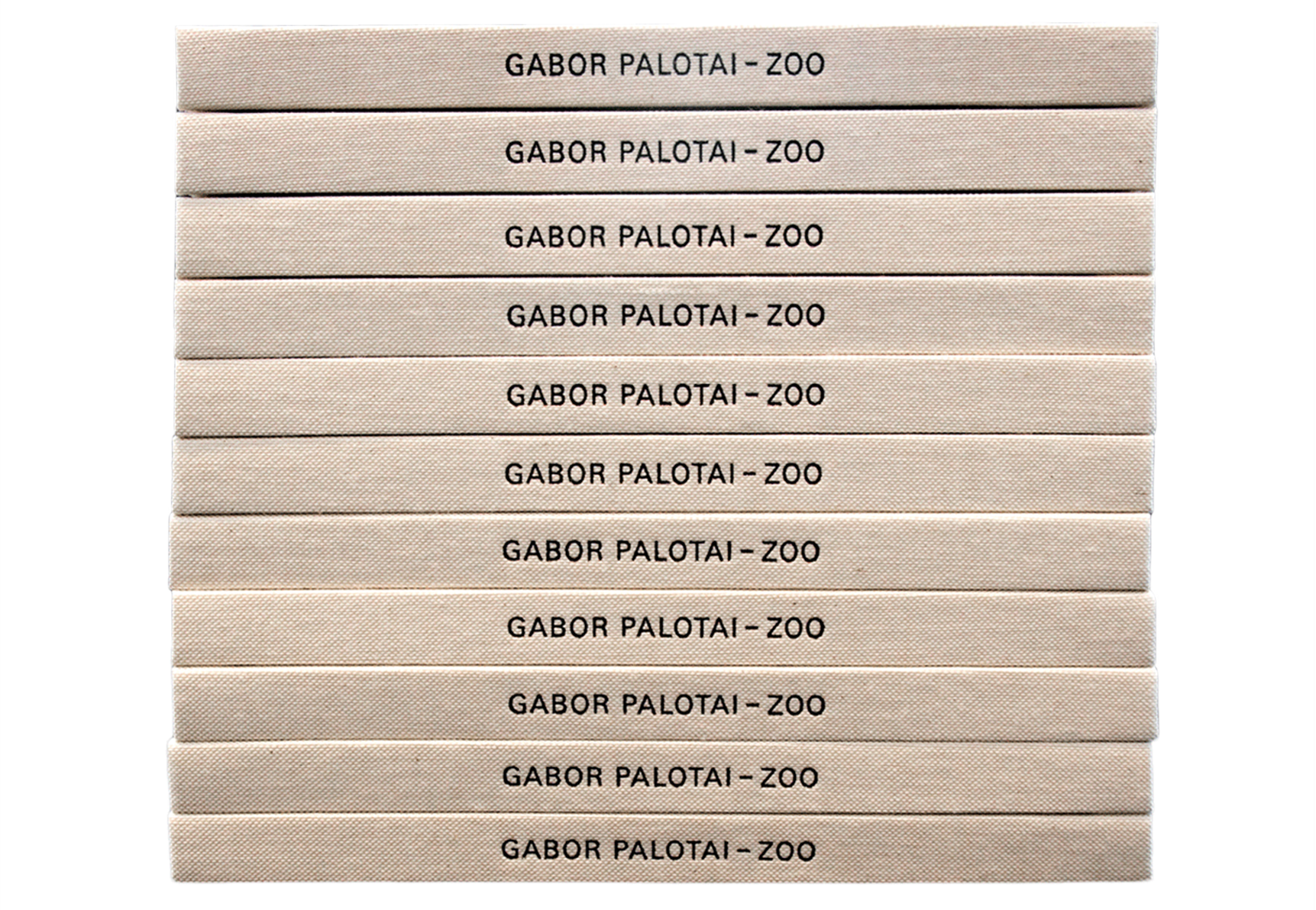

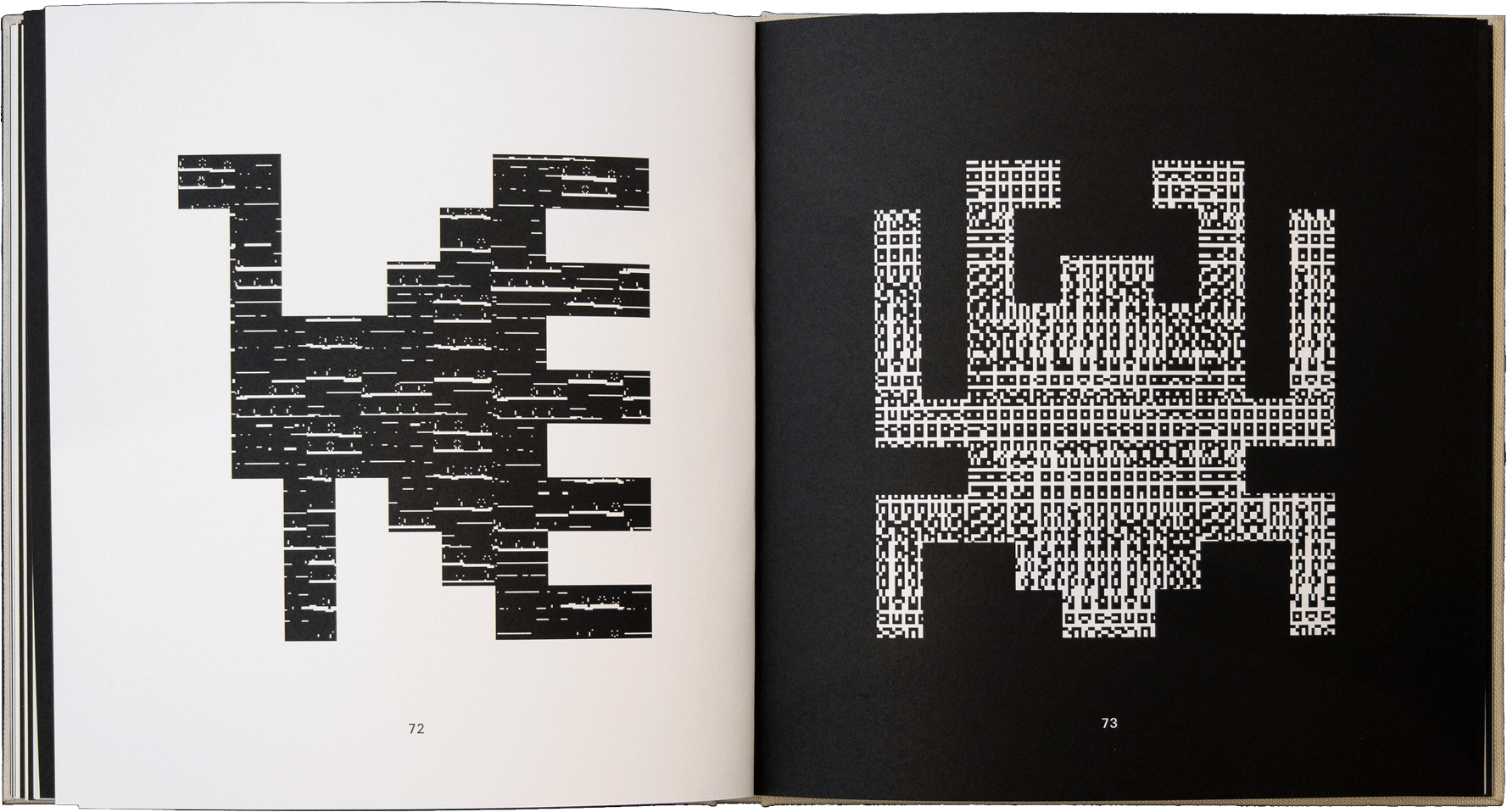
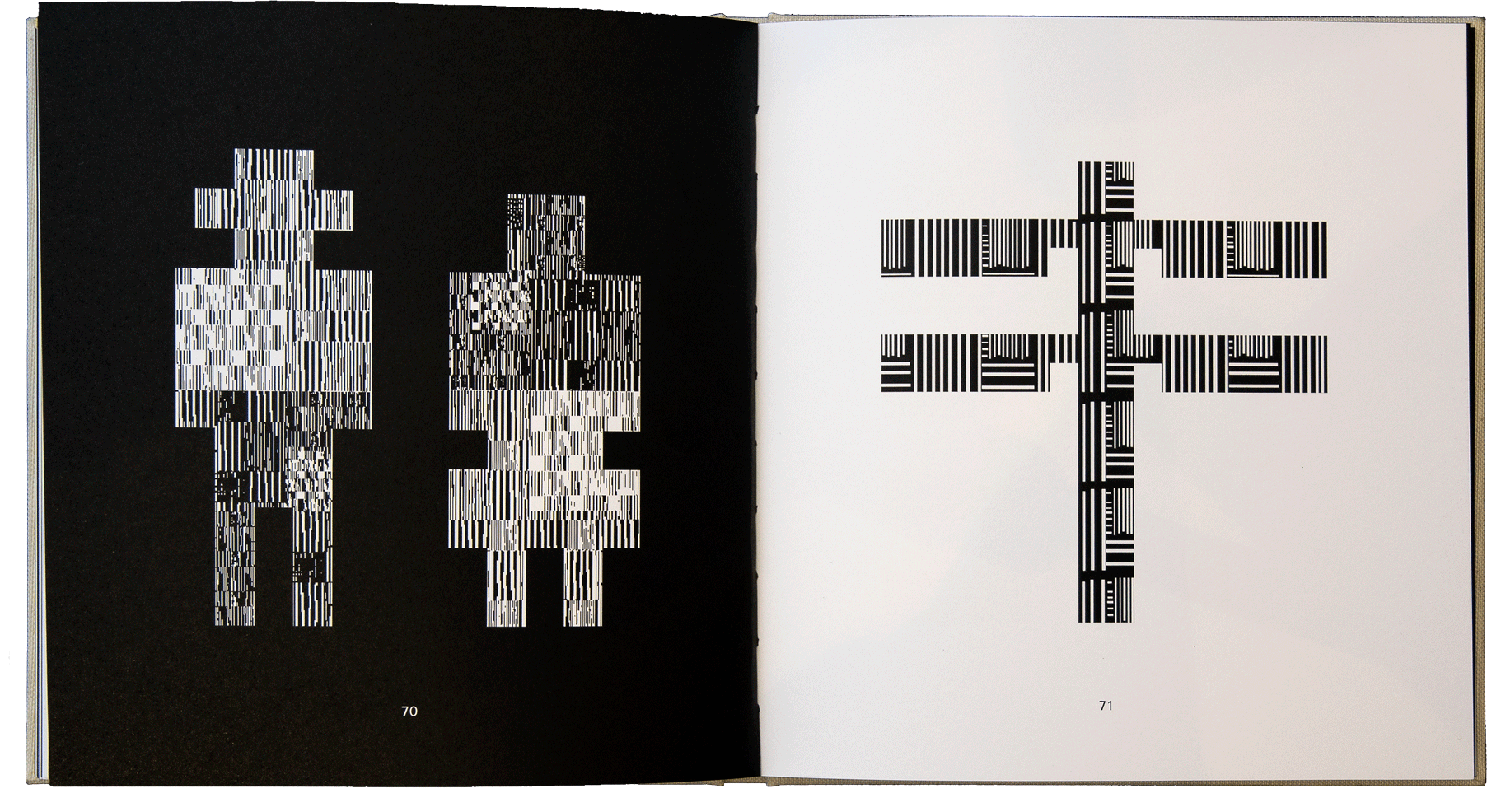
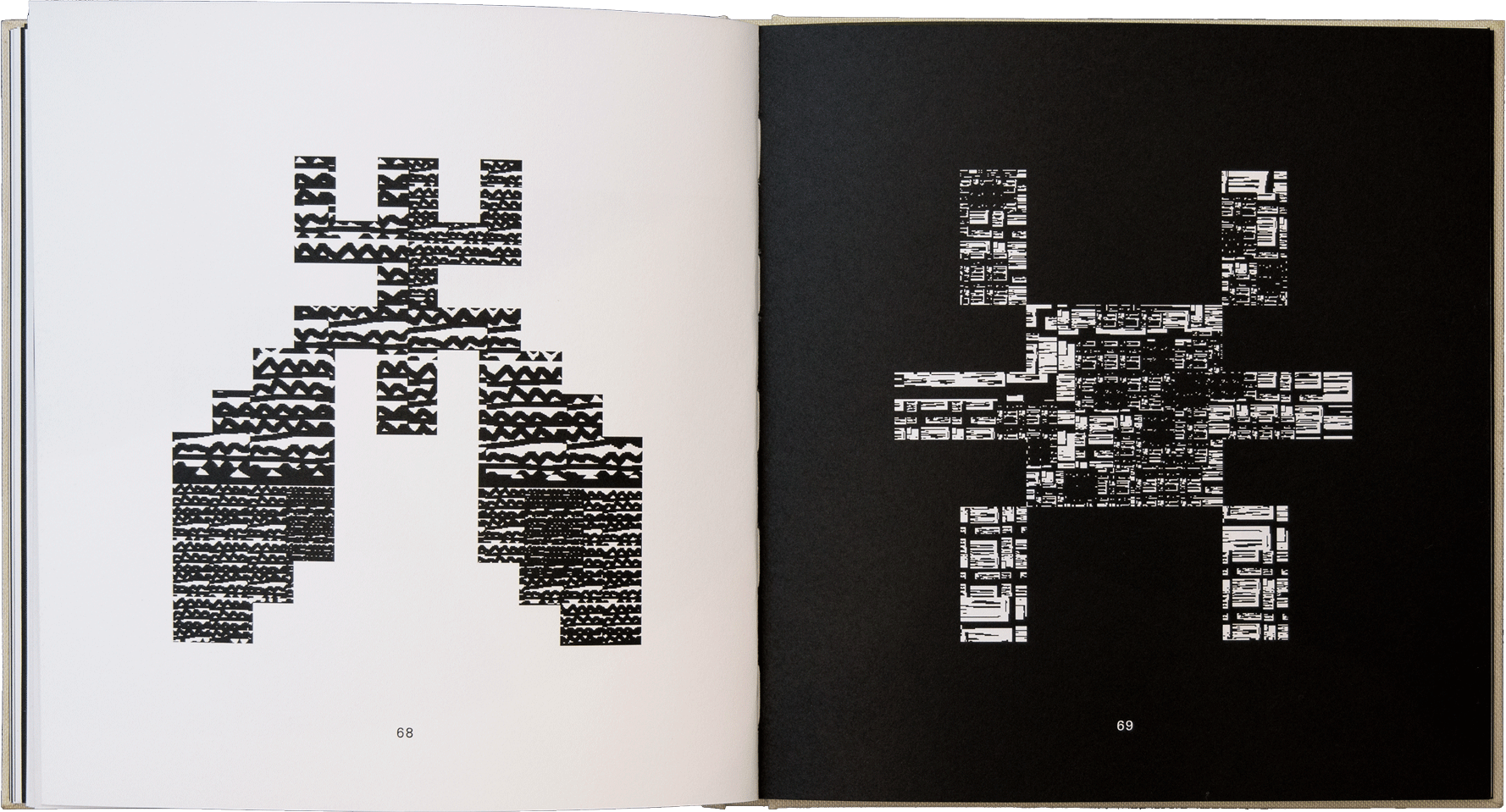
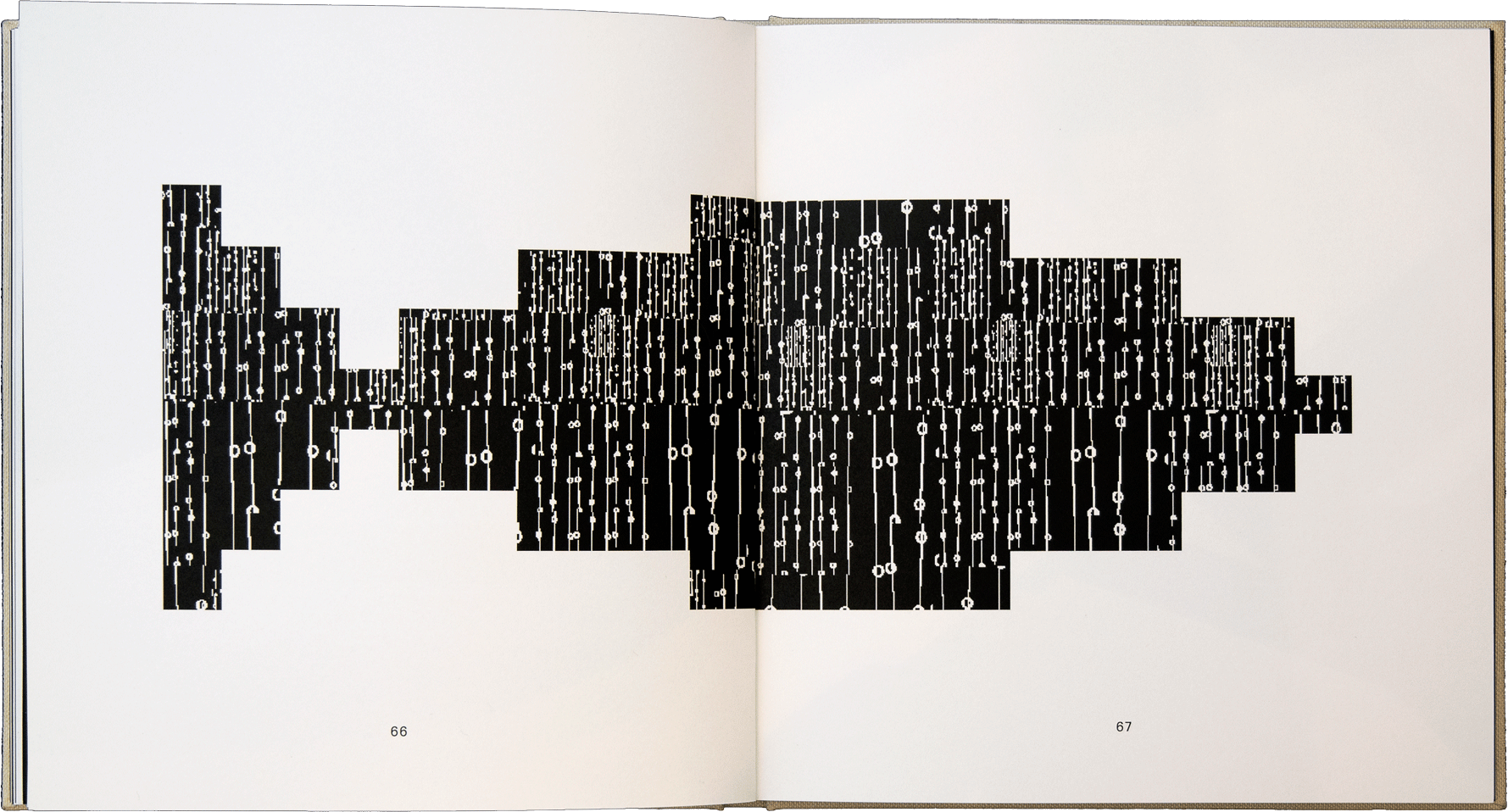




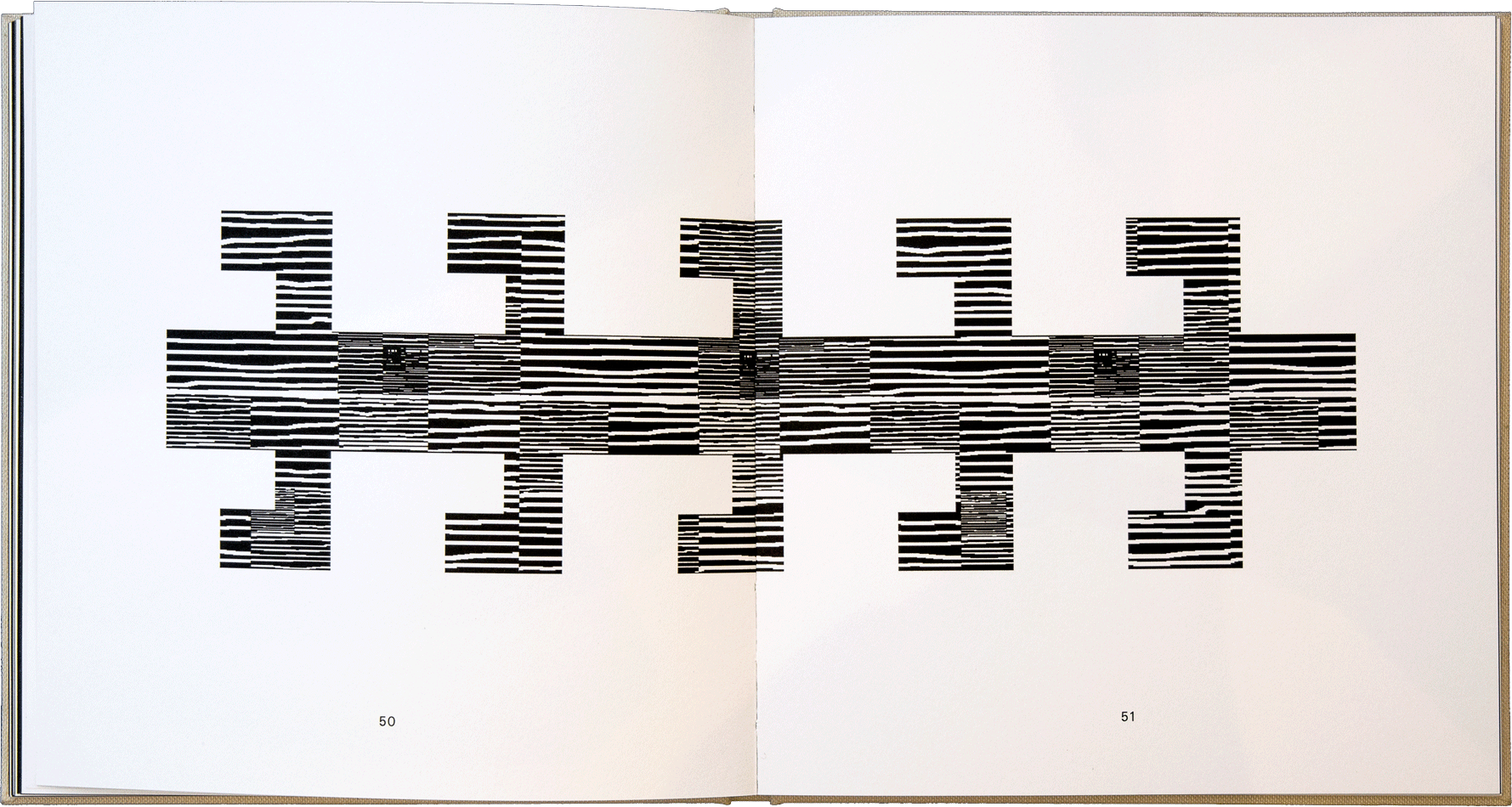



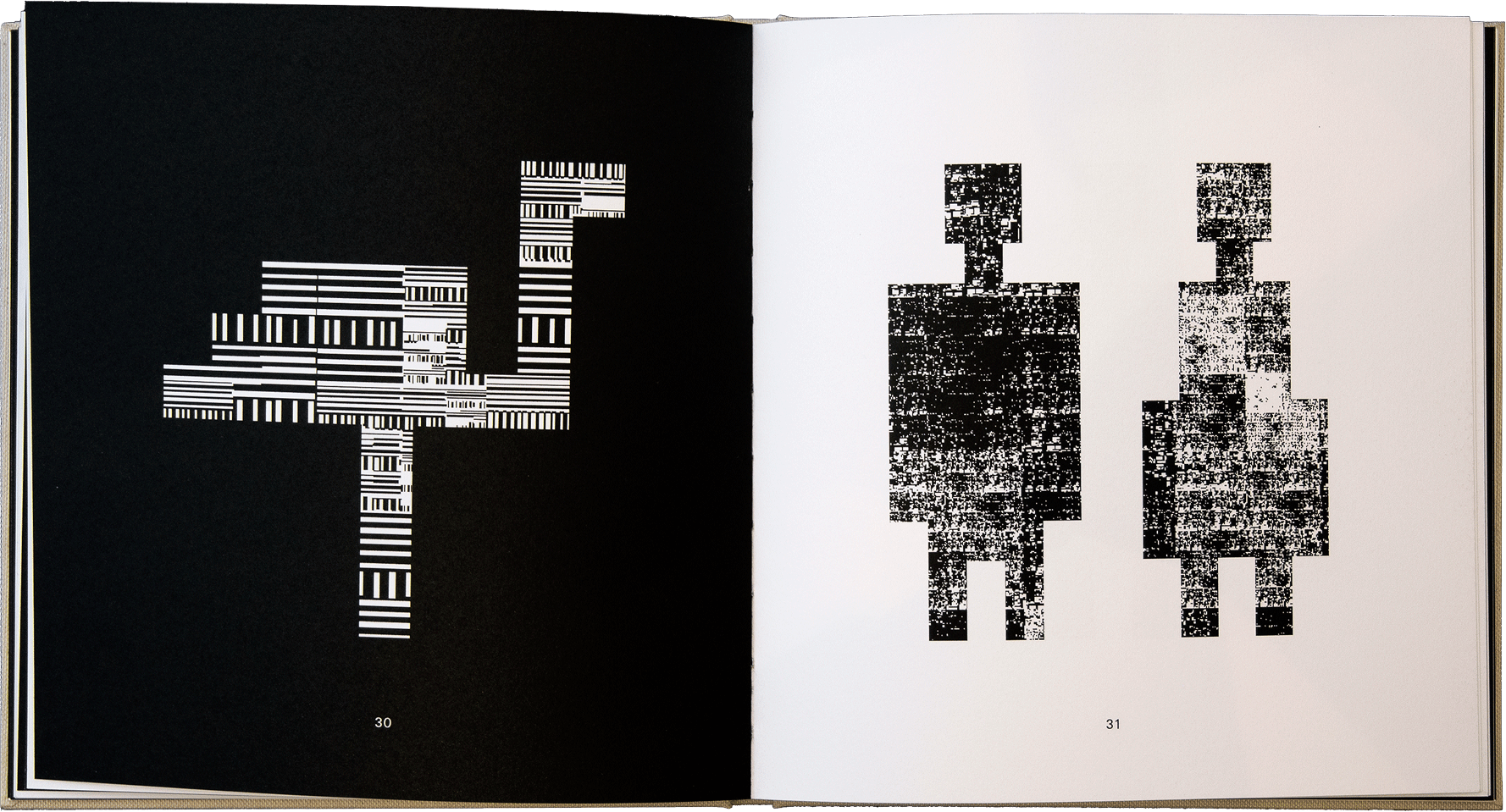



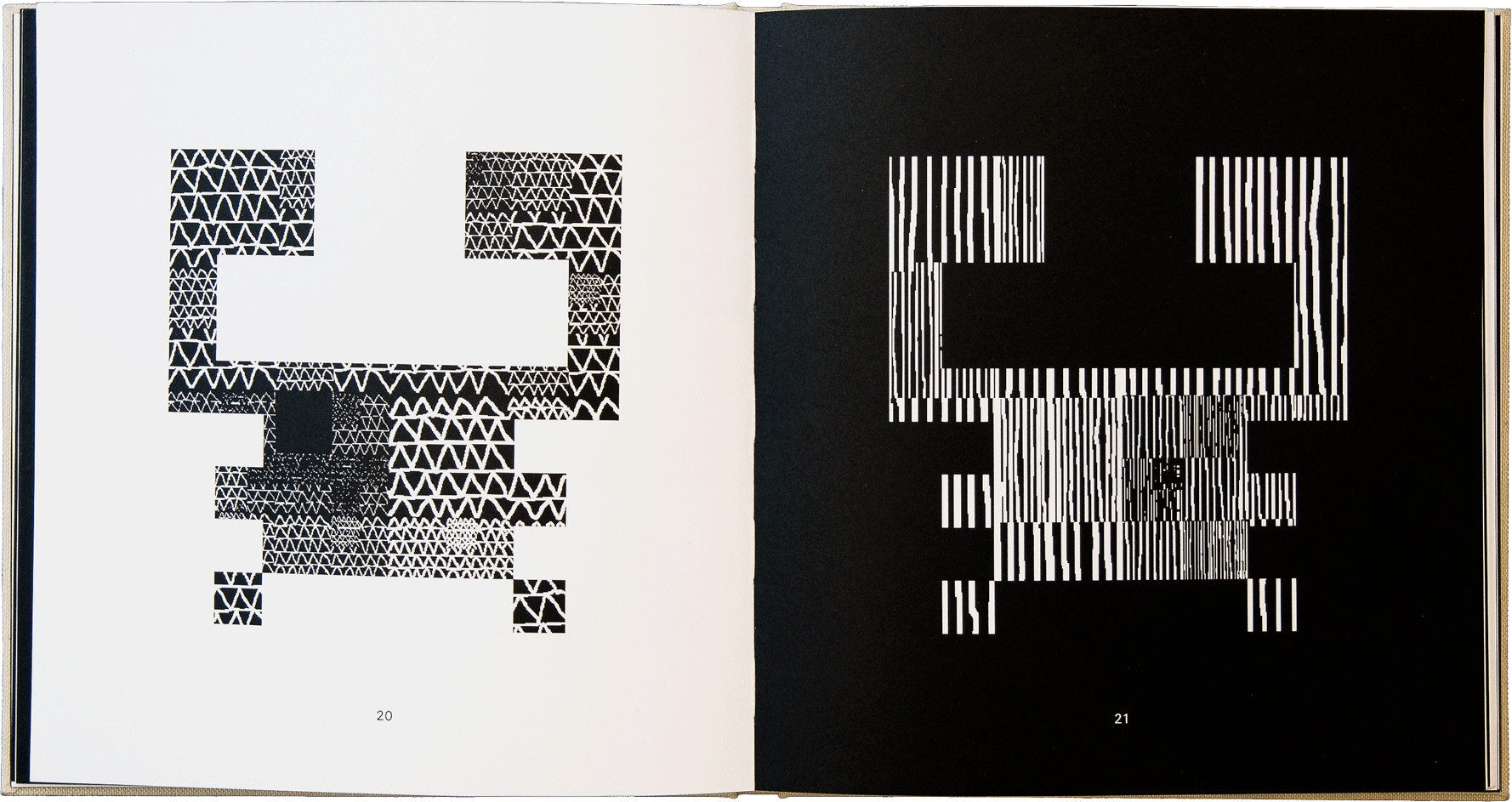
ZOO by Gabor Palotai
2017
I have several feet, an elongated neck and no head. But I am thinking. My thoughts are all over the paper. When my skin is cut open, my body can take any shape. I can turn into you. Exposed, I come to life in your photographic eyes. But before you can see me, I ensnare you in a trap of words. Most of the time, introductions in art books are camouflage (from French camoufler, to disguise, probably from Italian camuffare, to veil, hence, capo muffare, ‘to muffle the head,’ et cetera). This text blows smoke in your eyes. Because the function of any verbal introduction to visual works of art acts as an instruction that says: Look upon these images like this!
Penetrate the matrix of the pattern of black letters piercing white paper and think of the word animal (from Latin animalis, living, breathing, from anima, breath, soul, hence animare, bring to life) – then what comes to mind? Your mirror image? Seldom, the rhinoceros stands in front of the mirror and says: Look at (and never beyond) my armor! The White Rabbit and the March Hare might have. But the dandy is dead and the hare was mad. In fact, I’m mad. You’re mad (Lewis Carroll).
Are we going to get crazy now? Of course not. We are already as insane as the broken dawn casting white bolts through the coal pit black sky. What a pattern to follow. Not even the multiple eyes of the peacock’s tail know in what direction to look. Does it only rhyme, or does this psychedelic pattern propose a path? If so, where does it lead? The snake takes the shape of a maze and the dragonfly is caught with its wings spreading in every cardinal direction.
A pattern by definition suggests a model to be imitated, but how can we distinguish the pattern from the patterned. The zebra cannot, because we all are false sphinxes, with no idea of what we are in reality (Fernando Pessoa). And who cares who you are – not? The ants say reality is in your head – otherwise you would be unthinkable and unseeable. The seahorse does not bother to answer and the caterpillar disguises itself in order to hold an advantage – to see, but not to be seen. On the outlook, rubbing, barking, feeling, howling, singing, when you close the book.
2017
I have several feet, an elongated neck and no head. But I am thinking. My thoughts are all over the paper. When my skin is cut open, my body can take any shape. I can turn into you. Exposed, I come to life in your photographic eyes. But before you can see me, I ensnare you in a trap of words. Most of the time, introductions in art books are camouflage (from French camoufler, to disguise, probably from Italian camuffare, to veil, hence, capo muffare, ‘to muffle the head,’ et cetera). This text blows smoke in your eyes. Because the function of any verbal introduction to visual works of art acts as an instruction that says: Look upon these images like this!
Penetrate the matrix of the pattern of black letters piercing white paper and think of the word animal (from Latin animalis, living, breathing, from anima, breath, soul, hence animare, bring to life) – then what comes to mind? Your mirror image? Seldom, the rhinoceros stands in front of the mirror and says: Look at (and never beyond) my armor! The White Rabbit and the March Hare might have. But the dandy is dead and the hare was mad. In fact, I’m mad. You’re mad (Lewis Carroll).
Are we going to get crazy now? Of course not. We are already as insane as the broken dawn casting white bolts through the coal pit black sky. What a pattern to follow. Not even the multiple eyes of the peacock’s tail know in what direction to look. Does it only rhyme, or does this psychedelic pattern propose a path? If so, where does it lead? The snake takes the shape of a maze and the dragonfly is caught with its wings spreading in every cardinal direction.
A pattern by definition suggests a model to be imitated, but how can we distinguish the pattern from the patterned. The zebra cannot, because we all are false sphinxes, with no idea of what we are in reality (Fernando Pessoa). And who cares who you are – not? The ants say reality is in your head – otherwise you would be unthinkable and unseeable. The seahorse does not bother to answer and the caterpillar disguises itself in order to hold an advantage – to see, but not to be seen. On the outlook, rubbing, barking, feeling, howling, singing, when you close the book.
Open the book and enter the ZOO (from Greek zoion, a living being, an animal). Something is happening here. But what? A surgical incision of the tissue textures? A template without a paragon? The ZOO of a ceremonial space where every animal is arranged in a central place? An art sharply outlined in contrast, but sketchy and troublesome in light and dark, overburdened with complex figures and tangled paths evoking strange places, secret passages, and unexpected communications (Michel Foucault) or what? How can we possible know, when black is transformed into white, hierarchical is horisontal, and concrete turns into abstract at one glance?
Is this the pattern of the palimpsest, of lived time as several ongoing times, interconnected, disconnected, reconnected in layers of a past weaving (vowing) a future? A texture entangled, yarns of twisted cloth, in skein reminiscences of remote experiences. He is aging and the life he has lived tattoos him with white cuts all over his black skin. By now, her life disguises any clear meaning. Is she wandering in the zoologischer garten of thoughts, seemingly disconnected from reality? In the woods, black branches of naked trees cast their moonlit shadows over the body of the wolf. Or is the tiger’s sleep only a dream cut out of daylight, a text without context, like figures cut out of a paper without leaving an incision? You do not have to tell. Hell, silence. The shadow of the scorpion’s tail swells at every turn of the page.
The animal is not. You become an animal. In Franz Kafka’s The Metamorphosis (1915) Gregor Samsa experiences that in the same moment you resist to live the life of everyone’s life (Gilles Deleuze) you will wake up one morning as a horrible vermin with the habit of crawling crisscross over the walls and ceiling (Franz Kafka) estranged from family and withdrawn from other people’s lives. The mere sight of him as an insect evokes repulsion and emprisons him in the gaze of others. The toad is cursed by spittle. But who is disgusting? A spider’s web becomes the projection surface of a psychosis. In this psycho-pattern, the fly can never be the other. The eagle in heraldry knows that, spreading his wings to make his coat of arms your shield.
Is this the pattern of the palimpsest, of lived time as several ongoing times, interconnected, disconnected, reconnected in layers of a past weaving (vowing) a future? A texture entangled, yarns of twisted cloth, in skein reminiscences of remote experiences. He is aging and the life he has lived tattoos him with white cuts all over his black skin. By now, her life disguises any clear meaning. Is she wandering in the zoologischer garten of thoughts, seemingly disconnected from reality? In the woods, black branches of naked trees cast their moonlit shadows over the body of the wolf. Or is the tiger’s sleep only a dream cut out of daylight, a text without context, like figures cut out of a paper without leaving an incision? You do not have to tell. Hell, silence. The shadow of the scorpion’s tail swells at every turn of the page.
The animal is not. You become an animal. In Franz Kafka’s The Metamorphosis (1915) Gregor Samsa experiences that in the same moment you resist to live the life of everyone’s life (Gilles Deleuze) you will wake up one morning as a horrible vermin with the habit of crawling crisscross over the walls and ceiling (Franz Kafka) estranged from family and withdrawn from other people’s lives. The mere sight of him as an insect evokes repulsion and emprisons him in the gaze of others. The toad is cursed by spittle. But who is disgusting? A spider’s web becomes the projection surface of a psychosis. In this psycho-pattern, the fly can never be the other. The eagle in heraldry knows that, spreading his wings to make his coat of arms your shield.
You are an animal and every animal is alone. But your skin is never a border, it is open-ended. Every pore is a hole. Dermapathology in X-rays are graphically to be seen. What do you see from within? Cut off the tongue of language and listen of what does the rat sing? I was used to the birds before (Emily Dickinson). The song is birdbrained for Aristotle who in The History of Animals (350 BC) is preoccupied with pigeonholing animals in a taxonomy that never puts into question the edges of a
limit that grows and multiplies by feeding on an abyss (Jacques Derrida). The wor(l)d animal is no longer what it is supposed to be. There are only poly-semous patterns without any given logic in this ZOO; it gives no clear checker-board of distinct characteristics; every pattern is different and any similarities cease to exist from within. The snake sheds its skin. The architectural outer shape of your body is con/temporary (there is no linear pre- or postcontemporary) and as such vulnerable to being designed in impossible shapes with any feature. Sirens sing. Oh, digital delirium.
The black bird with white hair reads the celebrated Chinese Encyclopedia that makes it possible for us to think of animals as drawn with a very fine camelhair brush, innumerable, embalmed, et cetera (Jorge Luis Borges). Heraldry and fable.Trolls and monkeys picking lice. An octopus tiara. An amulet of tadpoles in the snow. ZOO opens up the field of vision to thought without space (Michel Foucault) which implies seeing without space. Faces erode slowly from within in the dark desert sky. Memories of the lions’ parade on the Ishtar Gate and in black the white scream of hyena in the Lascaux Cave no longer killed by any gaze. The eyes of the fox seem to be healed from the wounds of the trap of words. What a world is this? Day turns into night before you have opened your eyes. What do you see? In the mirror I see you and you are making patterns – swirling, rubbing, barking, singing, howling, talking, reading, seeing, and dreaming. The animal is you – and you are already in the ZOO.
/ Linda Rampell
gaborpalotai-zoo.com
The black bird with white hair reads the celebrated Chinese Encyclopedia that makes it possible for us to think of animals as drawn with a very fine camelhair brush, innumerable, embalmed, et cetera (Jorge Luis Borges). Heraldry and fable.Trolls and monkeys picking lice. An octopus tiara. An amulet of tadpoles in the snow. ZOO opens up the field of vision to thought without space (Michel Foucault) which implies seeing without space. Faces erode slowly from within in the dark desert sky. Memories of the lions’ parade on the Ishtar Gate and in black the white scream of hyena in the Lascaux Cave no longer killed by any gaze. The eyes of the fox seem to be healed from the wounds of the trap of words. What a world is this? Day turns into night before you have opened your eyes. What do you see? In the mirror I see you and you are making patterns – swirling, rubbing, barking, singing, howling, talking, reading, seeing, and dreaming. The animal is you – and you are already in the ZOO.
/ Linda Rampell
gaborpalotai-zoo.com